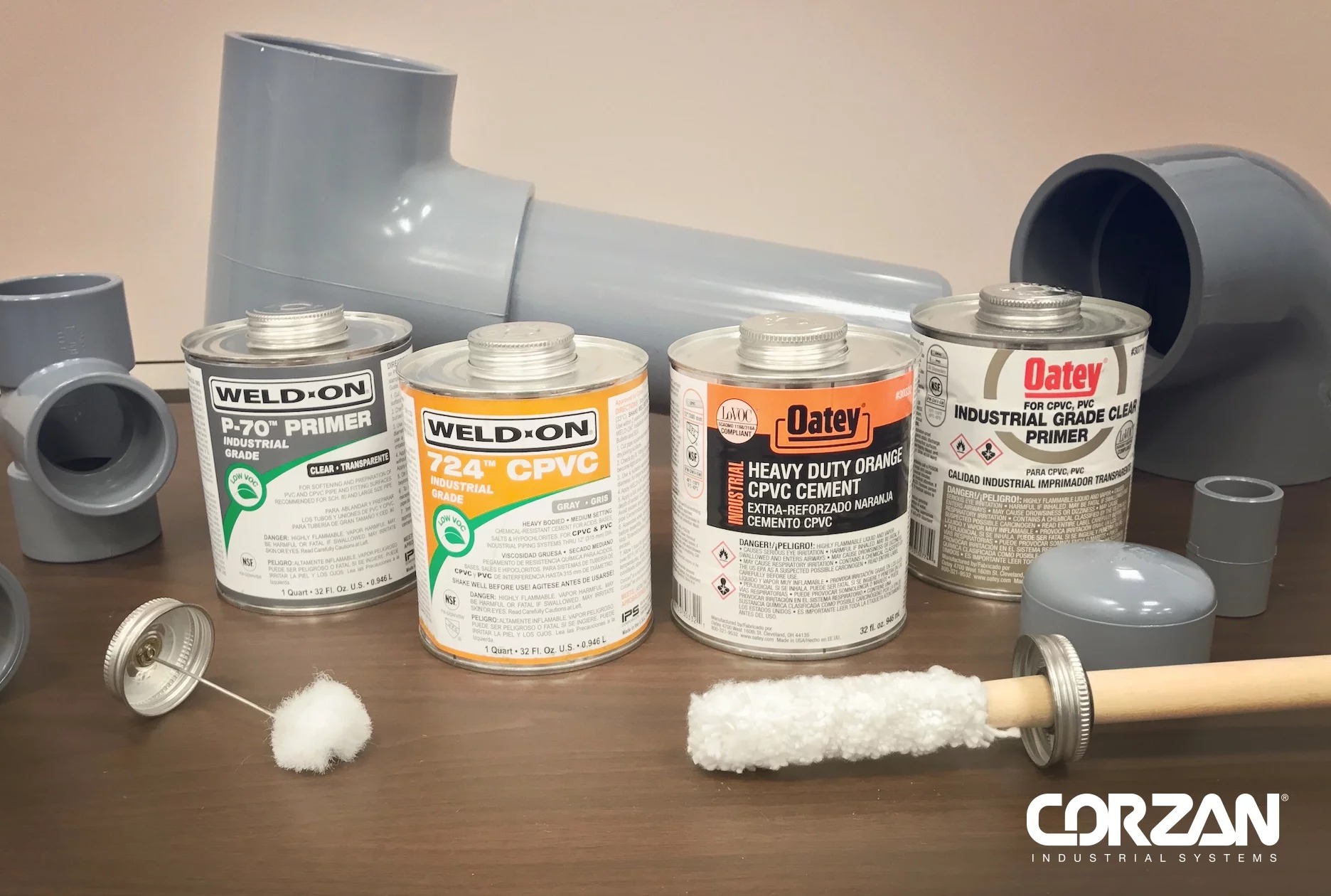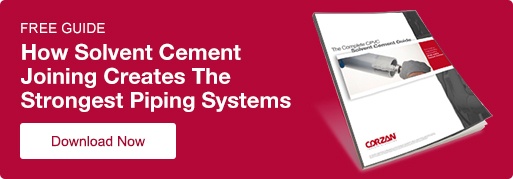WHAT IS SOLVENT CEMENT AND WHY IS IT USED FOR CPVC PIPING SYSTEMS?
This post was originally published in August 2017 and has been updated with additional information and resources, including The Complete Solvent Cement Guide.
Chlorinated polyvinyl chloride (CPVC) pipe and fittings are rapidly growing in popularity in both corrosive and high-temperature applications. One reason is, unlike traditional metallic pipes, CPVC piping systems are inert to most mineral acids, bases and salts found in mineral processing, chemical processing, power generation and wastewater treatment facilities.
CPVC piping systems don't always require solvent cement. Solvent cementing is just one way to join CPVC piping. Mechanical joining and thermal welding methods are sometimes applicable. Solvent cement is the most popular method due to its speed and simplicity. Glue must not be used with CPVC. Here are some basics about CPVC solvent welding.
What is Solvent Cement?
The most important thing to know about solvent cement is that it’s not glue. Solvent cement is made up of CPVC resin, stabilizers and fillers dissolved in a cocktail of solvents. These solvents serve two purposes:
- Dissolve the CPVC resin.
- Prepare the surface of the pipe and fitting.
When applied, the solvents soften and dissolve the top layer of the pipe and fitting material, loosening its molecular structure. A taper in the fitting socket creates an interference fit that ensures contact between the pipe and fitting. This allows the material to fuse to itself when the two pieces are connected. The CPVC resin is present to fill in any gaps that may exist.
Because this fusion occurs at the molecular level, when the solvent evaporates, the joint actually becomes one uniform piece. You should not attempt to connect CPVC to PVC with the same solvent cement. PVC and CPVC solvent cements are different. Each product is specially formulated to work best with each product to yield successful results. To connect these different types of pipe, use of a transition fitting is needed.
Solvent cement also contains stabilizers that maintain solvent properties and extend its shelf life. Specifically, these stabilizers help protect the solvent cement against heat and oxidation, which can degrade the solution.
Why Is It The Preferred Joining Mechanism for CPVC Piping?
The reason Corzan® Industrial Systems often recommends solvent cement is because it is a fast, easy and incredibly reliable joining method. Solvent cement fuses the CPVC material together, creating one uniformly bonded piece of thermoplastic.
These fused joints also help the system maintain its life expectancy, heat distortion temperature, pressure rating, chemical resistance and safety qualities.
See how a Corzan CPVC solvent cement welded joint performs in a burst test.
What Are The Different Types of Solvent Cements?
Solvent cement is typically a proprietary solution of solvents, stabilizers and fillers combined with a resin (e.g. CPVC). A more common way to distinguish solvent cement is by viscosity.
The viscosity of a solvent cement solution is determined by the amount of resin—the more resin, the greater the viscosity. The greater the viscosity, the better it can fill in any material gaps within the joint.
Generally speaking, solvent cement viscosity can be classified into one of three categories:
- Regular bodied
- Medium bodied
- Heavy bodied
The proper solvent cement category for a piping system is determined by the CPVC pipe diameter, schedule and application. The ASTM Standard Specification for Solvent Cements for Chlorinated Polyvinyl Chloride (CPVC) Plastic Pipe and Fittings (ASTM F493) provides the following guidelines for selecting solvent cement.
The standard notes that it is just a guide, and engineers should adhere to the manufacturer’s recommendation.
CPVC Cements for Schedule 40 Interference Fit Piping
|
Pipe Size Range (in.) |
Cement Type |
Minimum Viscosity |
Minimum Wet Film |
||
|
cP |
(MPa s) |
in. |
(mm) |
||
|
1/8 to 2 |
Regular Bodied |
90 |
(90) |
0.006 |
(0.15) |
|
2-1/2 to 6 |
Medium Bodied |
500 |
(500) |
0.012 |
(0.30) |
|
6 to 12 |
Heavy Bodied |
1600 |
(1600) |
0.024 |
(0.60) |
CPVC Cements for Schedule 80 Piping
|
Pipe Size Range (in.) |
Cement Type |
Minimum Viscosity |
Minimum Wet Film |
||
|
cP |
(MPa s) |
in. |
(mm) |
||
|
1/8 to 1-1/4 |
Medium Bodied |
500 |
(500) |
0.012 |
(0.30) |
|
1-1/2 to 6 |
Heavy Bodied |
1600 |
(1600) |
0.024 |
(0.60) |
Solvent Cement for Industrial Applications
For industrial applications, Corzan Industrial Systems recommends heavy bodied solvent cement solutions. That said, because heavier bodied solvent cements contain more resin, and consequently less solvent, a primer should also be used.
The primer is essentially additional solvents applied to the pipe and fitting first to help soften the material and free the surface molecules. The solvent cement is then applied to further the softening process and create a strong pipe and fitting connection.
Solvent Cement for Highly Corrosive Applications
When you get into some of the more aggressive, highly corrosive stream applications, there is another class of solvent cement specifically engineered for these industrial systems. These solutions do not contain fillers that can be attacked by certain chemicals and degrade the system.
Make sure to check the solvent cement manufacturer's label to ensure a cement is appropriate for your application.
Learn More About Solvent Cement
Go further in-depth on what solvent cement is, how it works and how installers can effectively join industrial systems using the method in the Complete CPVC Solvent Cement Guide.



